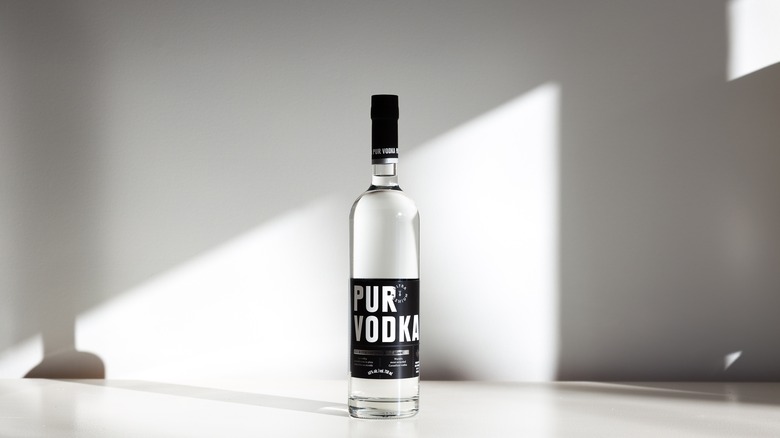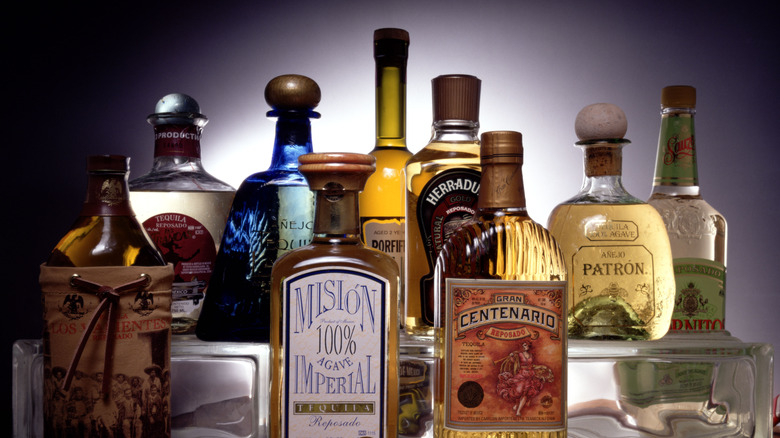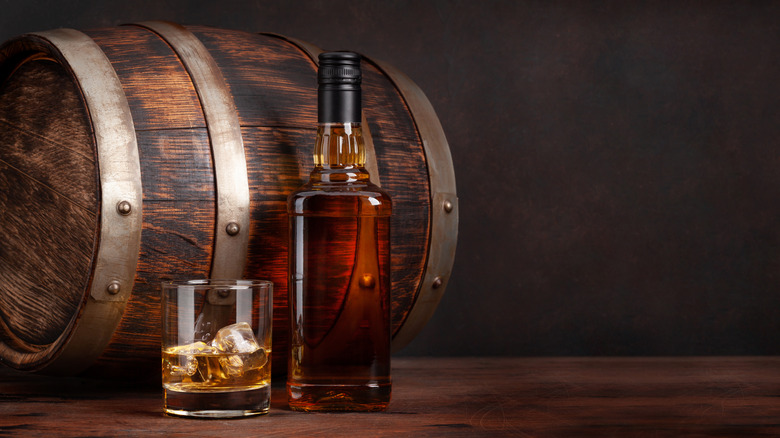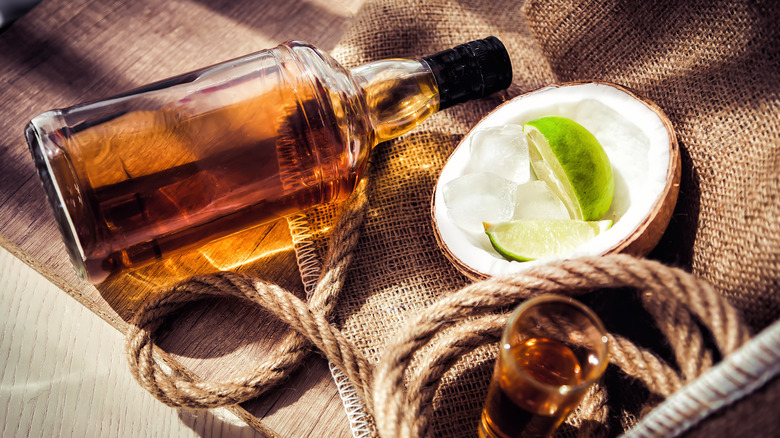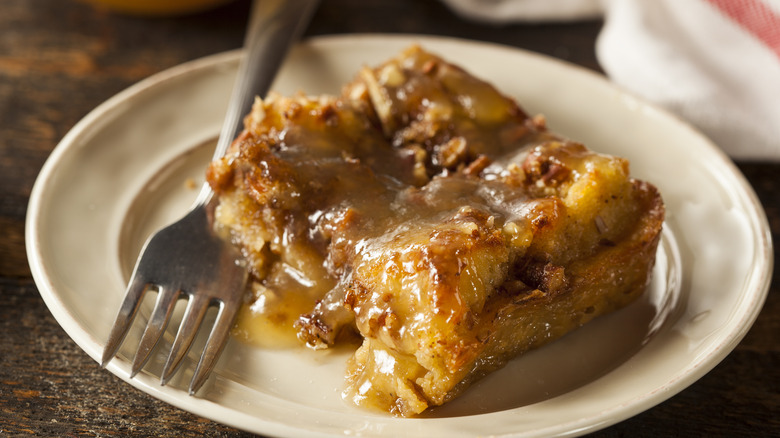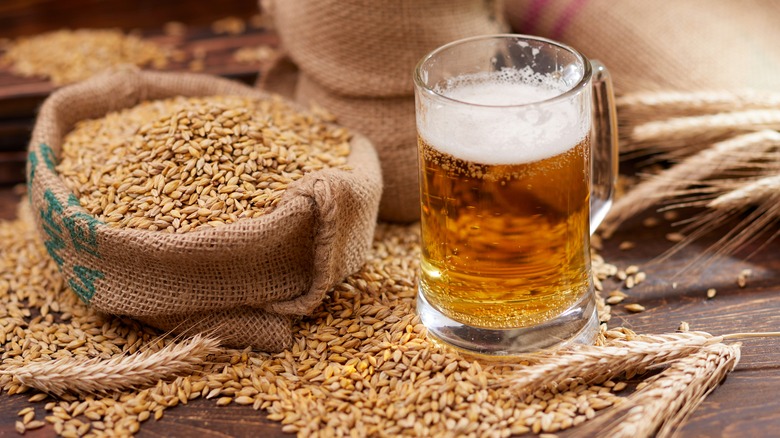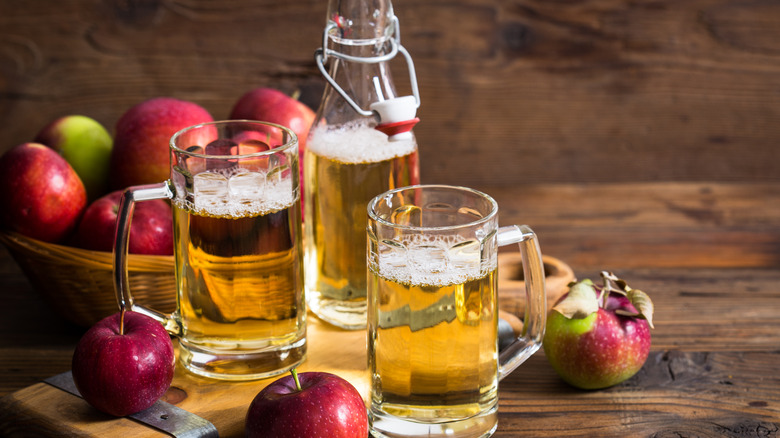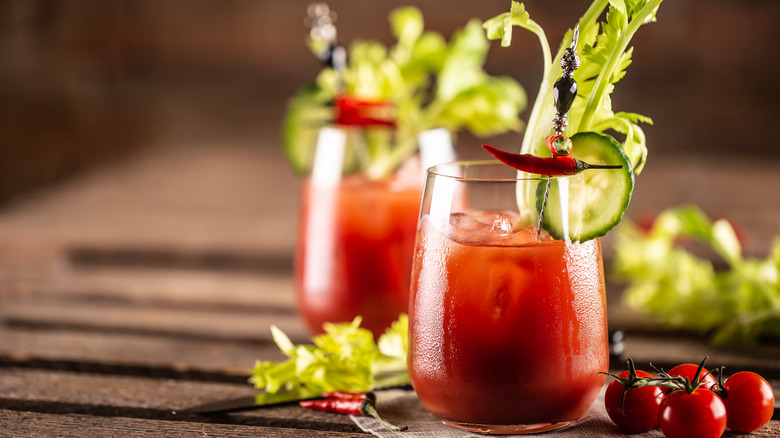12 Boozes You Should Be Adding To Butter
Discovering new flavors is one of the greatest joys in culinary adventuring. All it takes is a simple "What if?" to unlock a hidden treasure chest of delicious possibilities. When it comes to coaxing out the flavor, using butter is a tip you need to consider. Its creamy canvas is the perfect curator while cooking, adding color to ingredients and roundness to their natural taste. Its versatility also makes it great for blending, allowing for an almost endless combination of flavors. It all depends on the boundaries of your imagination.
Speaking of combinations, add some excitement to the mix by pairing booze with butter. It's a lesser-known yet interesting twist on compound butter that can bring out unexpected tastiness. Boozy butter works great with full-bodied recipes as well as lighter ones, depending on what type of liquor you use. Cooking removes the alcoholic content, while butter enhances the nuanced profiles, making for a mellow silkiness. Some recipes even call for retaining a bit of alcohol, which can bring a nice kick.
Not only do different types of alcohol produce unique results, but their age and method of aging are also factors. Another thing to keep in mind is that alcohol has a tendency to dry out meats, so the stronger the liquor, the higher chance of dehydration. With that said, all that's left is a little trial and error. Take a shot by trying the below list of booze and butter pairings.
Blend vodka with butter for improved taste
One unconventional use for vodka is pairing it with butter. To cook with this Russian spirit, it's recommended to use one you'd also drink yourself and is a lower, less flammable proof. Salted and unsalted can work for butter, whether you're making a savory or sweet recipe. Taste varies depending on what type of vodka you use. Wheat-based vodkas carry a light, crisp, and slightly sweet taste, adding a nice layer to butter's richer tones. To give butter a bolder edge, rye-based vodkas come with a black peppery spice yet are lean and dry.
Potato-based vodkas are oily with viscosity so they will add a bit of thickness to butter's silky texture. For a more rounded, sweeter touch, try infusing butter with corn-based types. Whichever you try, vodka butter is great as a creamy appetizer pairing. It can be used as a spread on lightly toasted bread that's layered with anchovies, lemon zest, and black pepper, or rather than anchovies, have an authentic eastern European experience by topping your toast with salo (Russian bacon) and spring onion. Vegetarians can substitute those with grilled mushrooms and artichokes or even forego toppings for a sweet blend of jam and marmalade.
Raise your spirits with tequila butter
With flavors that travel from sweet, fruity and floral to toasty, spicy, or earthy, tequila is an excellent pairing ingredient. Blanco is distinctly agave, with peppery citrus notes and a spicy finish. Mixing it with butter offers a light botanical subtlety to the creaminess. Slightly heavier, reposado's hints of vanilla, jasmine, and citrus play a smooth counterpart to butter's roundness. A lingering taste of oak can be found in añejo tequila, along with vanilla, caramel, butterscotch, and custard. Pairing the two makes for a buttery sweetness with a matured flare. Tequila connoisseurs may enjoy the complexity of ultra añejo, with its hints of agave nectar, saccharine caramel, vanilla, wood, and dried fruit.
For this boozy combo, lighter types can elevate seafood dishes, whereas a slightly aged reposado is wonderful with grilled vegetables. If you're planning more savory recipes that have a natural sweetness, an añejo is a recommended option. Barbeque, or sauces in Thai and Indian cuisines, also blend deliciously. When it comes to cooking, for a more pure tequila flavor, choose 100% agave. As the name suggests, it doesn't include sugars like types that are distilled with lesser agave. You can even spice your compound mixture up by adding chipotle pepper. With your pick of the litter, there are plenty of flavors for your culinary experiments.
Enjoy an oozey kick with whiskey butter
Add a zap of earthy sweetness by teaming whiskey with your butter. As is common in the liquor world, this rich-bodied spirit comes in many styles and flavors. To uncover the secrets of this sweet and savory combo, it's probably best to know what different whiskey types offer. Although there are over 10 kinds of whiskey, we'll just stick to some of the most popular and allow your curiosity to take things from there. One thing to note is that, whichever your choice, you don't need to break the bank with a top-shelf option. The best whiskey to cook with is the budget-friendly one.
Both whiskey and butter are known for bringing out flavor in recipes and adding a bit of their own. Scottish whiskey has a smokey to buttery flavor, with hints of malted rye and a spicy finish. It's great for savory cuts of steaks. Single malt whiskey is known for a noticeable malted barley taste that's naturally woodsy that nicely pairs with smoked salmon. Another popular type is Irish whisky. It's similar to Scottish in flavor yet has distinct touches of oak and caramel. Each option adds a unique character to your recipe. It's recommended to purchase miniature bottles since only a tablespoon or so is actually needed for this buttery blend.
Bourbon butter makes for juicier grilled meats
Fun fact, all bourbon is whiskey, but not all whiskey is bourbon. This American-made brand of brown booze only qualifies as bourbon if its mash contains at least 51% corn and it's been aged in new, charred oak barrels. One of the most popular liquors used in cooking, bourbon is known to enhance the taste of everything from salad dressings to fruits and desserts. Unlike other types of whiskey, its flavors are sweeter and include cinnamon, subtle vanilla, and even chocolate in some variations. Interestingly, these flavors come from the aging process and fermented mash, as adding flavors is typically frowned upon.
With bourbon butter, you can take savory eats, like grilled steak or reverse-seared pork chops, to new heights. Drizzle some over freshly baked hot biscuits to pamper your palate. For a smokey layer of haze, try Tennessee bourbon, which undergoes a charcoal filtration process, and sliced smoked bacon. Then add brown sugar to take advantage of bourbon's sweetness. Beyond tasty eats, this boozy butter combo can also be added to cocktails like this Trefoil Old Fashioned recipe.
Cognac butter is the flavor-topper you need
Use cognac to infuse your butter with the flavors of France. Depending on your selection, you can experience a wide array of tastes, including sweet caramel and vanilla to fruity orange or apricot. There are even bitter and spicy notes. The experience transforms depending on age, aroma, and type. That means your cognac butter can shapeshift, bringing exciting surprises to cooking. For cooking, it's recommended to go with either a VS (Very Special) or a VSOP (Very Superior Old Pale). Out of the available types of cognac, these two are aged the shortest.
VS must be aged at least two years, while VSOP requires four years of aging. Unlike older types, younger cognacs have stronger flavors, which won't get lost in the buttery sauce. This creamy couple tastes awesome with leaner cuts of meat like roasted filet mignon in saucy pasta dishes and fish, too. Aside from salty recipes, cognac butter is also delicious as a spread for toast, English muffins, and biscuits. If you have more of a sweet tooth, use it as a frosting for shortbread cookies, or lather it across pancakes or waffles.
Make rum butter for extra sweet richness
Considered to be the oldest alcoholic spirit in human history, according to The Rum Lab, this sweet and toasty-flavored liquor has been giving people the tipsies for centuries. To have lasted this long, it has to be good. Besides being a classic alcoholic drink, it's also a proven flavor booster when paired with food ingredients. Through its sugarcane distillation, you'll find notes of tropical coconut and banana or spices like vanilla and clove. Each of these blends seamlessly with butter's rich and sweet taste. There are two main types of rum, white and dark, and both can be used for this creamy combination.
White rum butter is a fantastic addition to seafood and vegetable recipes with its lighter-bodied flavor. It also can be used on toast, crackers, buttermilk scones, or as they do in the UK, atop yummy and gooey Christmas pudding. Aged rums are typically better for dishes with stronger flavors, like pork or a stew, adding rich caramel and vanilla strokes. For culinary daredevils, try spiced rum butter to give your dish a taste of oak and pepper.
Brandy butter is a subtly sweet pudding pairing
Similar to the difference between whiskey and bourbon, all cognac is brandy, but not all brandy is cognac. Brandy differenceWhile there are many types of brandy, they all share one thing in common: they're produced from fermented fruits. Grapes are the most common, yet you'll also find apples, apricots, and peaches. The fermentation process imparts brandy with the subtly sweet fruity notes it's known for. Along with the fruit, its flavor profile also includes floral accents and, depending on the age, oak.
For your brandy butter recipe, it's best to go with a mid-priced VS or VSOP option rather than going on a spending spree. A younger VS has a more pronounced taste of fruit, while a VSOP is smoother, with touches of oak and spice. Either way, you'll only need a small amount to make delicious brandy butter due to its strong flavor. Blending the two will result in a creamy, fruity taste, with slight strokes of woodsy alcohol. This luscious combination will perfectly sauce seafood and meats, enhancing the overall flavor. You can also spruce up savory mashed potatoes, pasta dishes, and vegetables. Add vanilla to the mix for a burst of sweetness. It's a satisfying compliment to panettone French toast or seasonal British classics like Christmas pudding and mince pie recipes.
Elevate summertime grilling with beer butter
As you begin planning your summer get-togethers, a slew of succulent meats will no doubt grace your grill. One of the most satisfying parts of grilling is taking a perfectly cooked cut of meat off the flame and successfully retaining its juicy goodness. Using butter is one of the best ways to achieve the meaty plumpness your tummy is impatiently waiting for. Although butter is perfectly awesome alone, you can take a butter-basted steak out of this world with the addition of beer. Cooking with beer offers up various flavor profiles, which can make for exciting results when combining the two. Butter's creamy richness balances with the bitterness of hops and natural malty sweetness.
Wheat beers that carry a bready flavor will remind you of butter-topped toast. It'll go nicely with lighter chicken or seafood recipes. Try blending butter with a bitter stout or ale for heartier dishes like beef stew or lamb shanks. Mix your butter with ale, porter, or stout if you're searching for a savory companion for pork, beef, and lamb. On the sweeter side of things, fruity beers are awesome pairings for butter; they enhance desserts. At the same time, chocolate lovers will enjoy a more complex, darker stout butter that highlights the cocoa.
Put your pinky up with pinot grigio butter
Breathe new life into lighter recipes with pinot grigio butter. Finding its origins in Italy and France, where it's called pinot gris, this grayish-purple grape tantalizes the tongue with flavors of lime, lemon, pear, white nectarine, and apple. It's mostly known for its refreshing citrus flavor and tangy acidity, joined by faint whispers of honey and floral aromas. When combined with creamy butter, roasted garlic, parsley, and parmesan, pinot grigio's acidity is calmed, allowing a tasty layer of fruity citrus and sweet honeysuckle to pop through.
There are three main types of pinot grigio to choose between French, Italian, and American styles. You can also elevate your butter further with a special Alsace pinot gris, made with 100% pinot gris grapes that often exude cinnamon and clover flavors. As Alsace is a rarer find, more than likely, you'll come across one of the main three mentioned. French carries faint honey notes that match deliciously with butter. Fancify your garlic bread recipe with it, or drizzle some over-roasted veggies. Italian is distinct for being dryer and more acidic, with a bitter almond touch. Its fruity almond accents blend perfectly with fish and shellfish. American pinot butter, which will be more full-bodied, can take on richer dishes.
Add some classy oomph with red wine butter
Bring a burst of flavor and color to your compound butter with red wine. When deciding the best red wine for cooking, you can choose a well-rounded cabernet sauvignon, a peppery shiraz, or fancier Beaujolais with high tannin content. There are many options to choose between that will complement butter. This simple yet gratifying combo soars high with freshly minced garlic, sea salt, and ground black pepper. Or you can blend in garlic and herbaceous rosemary. Either selection of ingredients is bound to give you satisfying results.
Everyone knows red wine and meat pair perfectly, so we definitely recommend smearing this compound creation over seared steak for a creamy finish that's tasty and zestful. Reduce your red wine to concentrate the flavor and avoid a watery mixture. After it's reduced, add it to the mixture of your choice in a bowl and whisk away. Once your red wine butter is ready, it can be stored on roasted veggies, tossed with pasta or roasted potatoes.
Use hard cider butter for cozy comfort taste
Transform your next recipe with hard cider butter. Similar to wine, it's made from fermented apples rather than grapes, which gives it a prominent acerbic and bitter tart that's chock-full of apple deliciousness. When cooked with butter, the acidic bitterness becomes more subtle, bringing harmony to the cream and fruit flavor: It can vary depending on the type of apple used to make the cider. For example, Pink Lady or Braeburn will lean on the sour side, while Honeycrisp or Gala tends to be sweeter. Not to be confused with apple butter, in actuality, the apple flavor is way tamer and works more as an accent to butter.
Bring pleasure to your palate with this unlikely pairing by mixing in minced shallots and fresh sage, pure maple syrup, and a dash of salt to taste. You'll enjoy it on freshly baked biscuits and rolls or melted atop steak, chicken, and pork. Or spread it atop waffles to start the day on a tasty note.
Experience unexpected deliciousness with Bloody Mary butter
Add this unique pairing to the list of the oddest flavor experiments we dare you to try. Ranging from savory ingredients like Worcestershire sauce, hot sauce, garlic, and horseradish, to aromatic herbs and black pepper, bloody marys are the tomato-y cocktails you didn't know went great with butter. If you think about it, though, the combination isn't that far-fetched because if butter is known to compliment savory recipes, a creamy Bloody Mary should be more than appetizing.
Give grilled oysters a spicy kick of butteriness by pouring Bloody Mary-infused butter on top. The subtle fish flavor combined with mild vodka, peppery tomato, and melted butter will leave you wanting more and more. Like garnishes you'd typically find in Bloody Mary cocktails, this special compound butter is delicious with shrimp and bacon. For additional tang, add sun-dried tomatoes to your Bloody Mary recipe and melt the final results over a juicy steak.
Static Media owns and operates Mashed and The Daily Meal.

